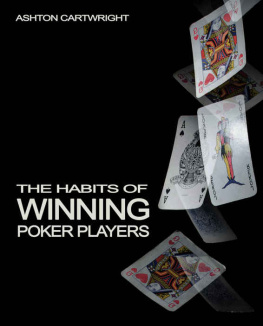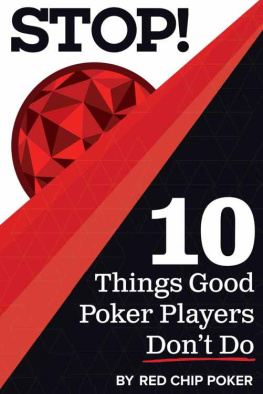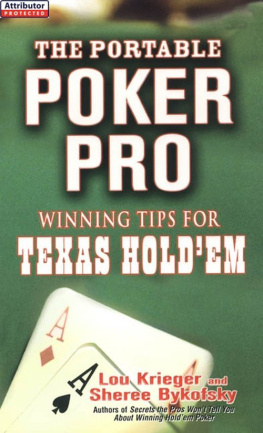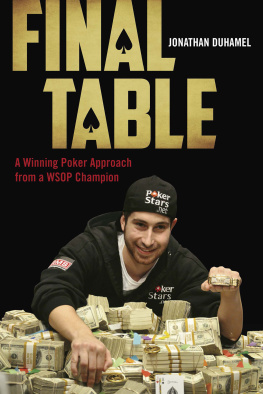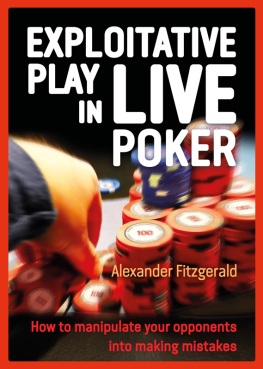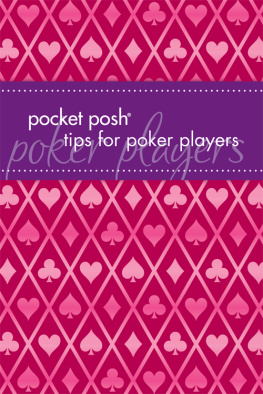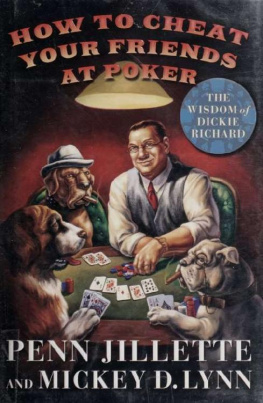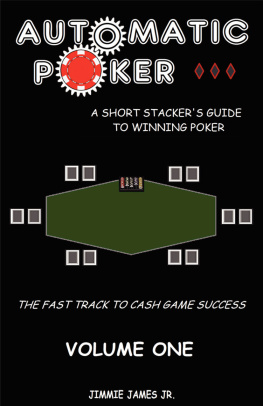Ashton Cartwright - The Habits of Winning Poker Players
Here you can read online Ashton Cartwright - The Habits of Winning Poker Players full text of the book (entire story) in english for free. Download pdf and epub, get meaning, cover and reviews about this ebook. year: 2015, publisher: Ashton Publishing Group, genre: Home and family. Description of the work, (preface) as well as reviews are available. Best literature library LitArk.com created for fans of good reading and offers a wide selection of genres:
Romance novel
Science fiction
Adventure
Detective
Science
History
Home and family
Prose
Art
Politics
Computer
Non-fiction
Religion
Business
Children
Humor
Choose a favorite category and find really read worthwhile books. Enjoy immersion in the world of imagination, feel the emotions of the characters or learn something new for yourself, make an fascinating discovery.
- Book:The Habits of Winning Poker Players
- Author:
- Publisher:Ashton Publishing Group
- Genre:
- Year:2015
- Rating:3 / 5
- Favourites:Add to favourites
- Your mark:
- 60
- 1
- 2
- 3
- 4
- 5
The Habits of Winning Poker Players: summary, description and annotation
We offer to read an annotation, description, summary or preface (depends on what the author of the book "The Habits of Winning Poker Players" wrote himself). If you haven't found the necessary information about the book — write in the comments, we will try to find it.
The Habits of Winning Poker Players — read online for free the complete book (whole text) full work
Below is the text of the book, divided by pages. System saving the place of the last page read, allows you to conveniently read the book "The Habits of Winning Poker Players" online for free, without having to search again every time where you left off. Put a bookmark, and you can go to the page where you finished reading at any time.
Font size:
Interval:
Bookmark:
The Habits of WinningPoker Players
By
Ashton Cartwright
Copyright 2015 byAshton Cartwright
This book isprotected under the copyright laws of the United States of America. Anyreproduction or other unauthorized use of the material or artwork herein isprohibited. Although the author and publisher have made every effort to ensurethat the information in this book was correct at press time, the author andpublisher do not assume and hereby disclaim any liability to any party for anyloss, damage, or disruption caused by errors or omissions, whether such errorsor omissions result from negligence, accident, or any other cause. Any views orstatements expressed are the opinions of the person making them, and notnecessarily the views of the author or publisher, and should in no way be takenas advice, financial or otherwise.
Acknowledgements:
Id like to thank allthe cool kids at Bernies Poker Room for all their inspiration.
Also thank you to myproof reader Rhys, a modern day gentleman.
Table of Contents
Poker has become a globalphenomenon in recent years, and more and more people are getting involved,having fun, and sometimes winning big money playing.
But what it is that makes onepoker player successful time and time again, while another poker player nevermakes that big score? Why is it that the same group of top poker players keepturning up on final tables? What is it that lets some pro players win multipleWSOP bracelets in their career, while others struggle to barely make the cash?
The truth is that there are severalmain habits that the most successful poker players have, and these habits makeall the difference between winning and losing.
The best players in the worldhave each developed these habits in their own way, and use them to dominate anypoker table they find themselves playing on.
The good news is that any playercan learn these habits, and doing so will give you a much more effectiveunderstanding of the game, as well as a decided advantage over your opponents,both of which will help you show better results on the felt.
Poker is a dynamic game, and tobe successful, you have to constantly be improving and refining your game, yourplaying style, and your habits. This book was written so that you can take thenext step in your poker evolution.
With that out of the way, itstime to move onto the Habits of Winning Poker Players.
Many playerslearn just enough to lose money that they wouldnt ordinarily risk.
Ian Andersen
Lets start with the centralpremise of successful poker decisions: EV.
EV is a poker term that standsfor Expected Value or Expectation Value.
Simply put, it is the amount ofmoney you can expect to win or lose by taking a specific action in a specificcircumstance, if you could repeat that action an infinite number of times.
Using dice games as an example,imagine a friend offers to pay you 6 timesyour bet if your number comes up on a single die. If you bet $1 that the number6 will come up, your EV will be 0. For every 6 times you roll the die, you willwin once, (Winning $6, minus the $1 you bet, for $5 profit on that roll), andlose 5 times (losing $1 each time =$5 loss). Therefore if you repeat thesituation an infinite number of times, you can expect to come out exactly evenin the long run. Your EV is therefore 0.
Now lets say that your friendoffers you $12 if your number comes up. If you make this bet an infinite numberof times, you can assume that for every 6 times you play, it will cost you $6,and you will win $12 once, for a net profit of $6. Your EV in this situation is100%, because for every dollar you bet, you stand to make $1 profit on average.Obviously you might get unlucky and lose 20 in a row, or you might get luckyand win 20 in a row. The important thing to understand is that mathematically,you can expect to make an average of 100% profit each time you roll the die.
The most common use for EV(Expected Value) in poker is to determine the long-term profit or loss oftaking a specific action in a specific situation. As a poker player, you goalshould be to only play hands in +EV situations (i.e. a situation where youexpect to win money in the long run, rather than lose money).
Heres an example of EV inaction.
Youre in a hand with 7 8
8 ,and the flop comes A
,and the flop comes A 5
5 6
6 , giving you an openended straight draw. There is $100 in the pot, and your opponent bets all infor $20, and everyone else folds. You are pretty sure that you are behind atthe moment (since you only have 8 high), but any 4 or 9 will give you astraight, which will give you the nuts, winning you the hand.
, giving you an openended straight draw. There is $100 in the pot, and your opponent bets all infor $20, and everyone else folds. You are pretty sure that you are behind atthe moment (since you only have 8 high), but any 4 or 9 will give you astraight, which will give you the nuts, winning you the hand.
If you call, it will cost you $20to win $120. An open ended straight will complete about 31.4% of the time(lets call it a third of the time to make the math easy for this example), soif you call, you can expect to win about 1 time in 3. It turns out that your 33%equity in the $120 pot is worth about $40. Since it only cost you $20 to call,it proves that calling is a very +EV play in this situation.
If your opponent had bet all infor $300 however, it would be a different story. It would have cost you $300 tocall, making the pot $to win a $400 pot. 33% equity in a $400 pot works out at about$132, meaning that the $300 call would only return you $132 on average, for anet loss of $168 every time you called in this exact situation. This play wouldbe EV (or Neg. EV).
In practice its not usuallynecessary to work out the exact amount that a play is +EV or -EV. Its justimportant to work out which is which. If a play is +EV, you should usually doit, no matter if its +5% EV or +100% EV. If you will make money on the play,go ahead and do it.
Likewise its not necessary toknow exactly how EV a play is, because you dont want to do EV plays that are-1%, or 50%. Just knowing that a play is EV should be enough for you todecide not to play the hand in that particular way.
So how do you work out if a playis +EV or EV? It all comes down to knowing your outs.
Outs
An out is a card that willimprove your hand from a losing hand to a winning hand. Knowing how many likelyouts you have is an important part of being an effective poker player.
In the previous example with thestraight draw, you had eight outs to hit your straight; any 4 and any 9 bothcomplete your hand, and there are four of each of those cards left somewhere inthe deck.
Lets say instead that you hold A 6
6 on a board that reads 9
on a board that reads 9 J
J 4
4 . Now any of theremaining nine hearts in the deck will give you the nut flush, which is almostcertainly enough to win the hand.
. Now any of theremaining nine hearts in the deck will give you the nut flush, which is almostcertainly enough to win the hand.
Additionally, any Ace might beenough to win as well. There are 3 Aces left in the deck, so thats potentiallyanother three outs that you have, giving you a total of eleven outs.
While most people will be able tocalculate outs at the table, its worth memorizing the 5 most common draws thatyoull use again and again.
Font size:
Interval:
Bookmark:
Similar books «The Habits of Winning Poker Players»
Look at similar books to The Habits of Winning Poker Players. We have selected literature similar in name and meaning in the hope of providing readers with more options to find new, interesting, not yet read works.
Discussion, reviews of the book The Habits of Winning Poker Players and just readers' own opinions. Leave your comments, write what you think about the work, its meaning or the main characters. Specify what exactly you liked and what you didn't like, and why you think so.

